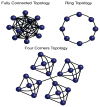Hierarchical winner-take-all particle swarm optimization social network for neural model fitting
- PMID: 27726048
- PMCID: PMC5253113
- DOI: 10.1007/s10827-016-0628-2
Hierarchical winner-take-all particle swarm optimization social network for neural model fitting
Abstract
Particle swarm optimization (PSO) has gained widespread use as a general mathematical programming paradigm and seen use in a wide variety of optimization and machine learning problems. In this work, we introduce a new variant on the PSO social network and apply this method to the inverse problem of input parameter selection from recorded auditory neuron tuning curves. The topology of a PSO social network is a major contributor to optimization success. Here we propose a new social network which draws influence from winner-take-all coding found in visual cortical neurons. We show that the winner-take-all network performs exceptionally well on optimization problems with greater than 5 dimensions and runs at a lower iteration count as compared to other PSO topologies. Finally we show that this variant of PSO is able to recreate auditory frequency tuning curves and modulation transfer functions, making it a potentially useful tool for computational neuroscience models.
Keywords: Biological neural networks; Evolutionary computation; Model optimization; Particle swarm optimization.
Figures






Similar articles
-
Discrete particle swarm optimization for identifying community structures in signed social networks.Neural Netw. 2014 Oct;58:4-13. doi: 10.1016/j.neunet.2014.04.006. Epub 2014 May 13. Neural Netw. 2014. PMID: 24856248
-
Optimized Particle Swarm Optimization (OPSO) and its application to artificial neural network training.BMC Bioinformatics. 2006 Mar 10;7:125. doi: 10.1186/1471-2105-7-125. BMC Bioinformatics. 2006. PMID: 16529661 Free PMC article.
-
Lévy flight-based inverse adaptive comprehensive learning particle swarm optimization.Math Biosci Eng. 2022 Mar 23;19(5):5241-5268. doi: 10.3934/mbe.2022246. Math Biosci Eng. 2022. PMID: 35430863
-
Particle Swarm Optimization for Single Objective Continuous Space Problems: A Review.Evol Comput. 2017 Spring;25(1):1-54. doi: 10.1162/EVCO_r_00180. Epub 2016 Mar 8. Evol Comput. 2017. PMID: 26953883 Review.
-
Application of particle swarm optimization to water management: an introduction and overview.Environ Monit Assess. 2020 Apr 13;192(5):281. doi: 10.1007/s10661-020-8228-z. Environ Monit Assess. 2020. PMID: 32285219 Review.
Cited by
-
Age-related Changes in Neural Coding of Envelope Cues: Peripheral Declines and Central Compensation.Neuroscience. 2019 May 21;407:21-31. doi: 10.1016/j.neuroscience.2018.12.007. Epub 2018 Dec 14. Neuroscience. 2019. PMID: 30553793 Free PMC article. Review.
References
-
- Ackley DH. A Connectionist Machine for Genetic Hill-climbing. 1. Kluwer Academic Publishers; Boston: 1987.
-
- Bastian M, Heymann S, Jacomy M. Gephi: An Open Source Software for Exploring and Manipulating Networks. International AAAI Conference on Weblogs and Social Media. 2009:1–2.
-
- Birge B. Particle Swarm Optimization Toolbox. 2006.
-
- Blum C, Roli A. Metaheuristics in combinatorial optimization: Overview and conceptual comparison. ACM Computing Surveys. 2003 Sep;35(3):268–308.
-
- Carnevale NT, Hines ML. The NEURON Book. Vol. 30. Cambridge University Press; 2006.
MeSH terms
Grants and funding
LinkOut - more resources
Full Text Sources
Other Literature Sources

